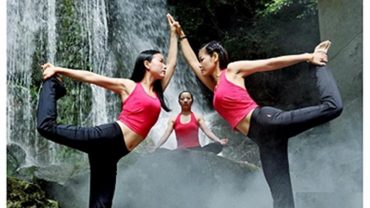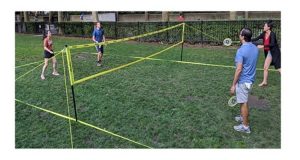
Once the preserve of Hindu holy men, Yoga is now a worldwide phenomenon. Yoga originated in India in the seventh century BCE. The practice encompasses physical and mental exercises, breathing techniques and meditation.
Compared to other SPORTS such as swimming or tennis, yoga has the advantage that it can be practiced more or less anywhere. But is that the only reason it has travelled around the world? From the shores of India to a staple of high-street gyms, here we take a look at the evolution of modern yoga.
To figure out how yoga traveled around the world, BBC News looked at its history.
Calcutta resident Swami Vivekenanda is seen as the man who brought yoga to the West. The monk traveled to the Parliament of Religions in Chicago in 1894 and spoke about India and Hinduism, before embarking on an influential lecture tour of the United States. His book Raja Yoga was written in Manhattan in 1896 and had a major impact on Western understandings of what yoga was. Over the coming decades more teachers and disciples of Indian gurus would travel to Europe and America.
Later, in the 1960s, several travelers on the hippie trail ended up in Indian ashrams. Images of The Beatles visiting the Maharishi Mahesh Yogi in Rishikesh in 1968 drew greater international attention towards Indian spiritualism and, of course, yoga.
Watch: Rishikesh – Beatles With The Maharishi (1968)
Yoga in North America
Yoga was introduced to the West in 1893 by Swami Vivekananda when he spoked about the benefits of yoga at the Parliament of Religions in Chicago. However, the number of people practicing yoga remained few and, when practiced in the west, yoga was interpreted as merely a physical practice rather than as a spiritual one.
After years later, yoga started expanding in North America when Indra Devi opened a yoga studio in Hollywood in 1947, and it became more widely practiced in North America. She was the first Westerner to study with Sri Krishnamacharya and the first to bring his lineage to the West. He went on to become the grandfather of American yoga; his students included B.K.S. Iyengar, Pattabhi Jois, and T.K.V. Desikachar. Yoga was established on the West Coast in the mid-’50s.
The first yoga studio in the United States was opened in West Hollywood in 1947 by an actress named Indra Devi. She is famously known as the First Lady of Yoga. #InternationalDayOfYoga pic.twitter.com/1oRzdNmEr7
— U.S. Embassy India (@USAndIndia) June 20, 2021
In 1973 Mr. Iyengar was invited to Ann Arbor, Michigan, to teach by Mary Palmer (mother of Mary Dunn). Nearly every Western teacher has been influenced by his emphasis on anatomical precision, many without even knowing it.By the ’70s, yoga and spiritual teachings were everywhere. In 1975 Pattabhi Jois made his first visit to the United States and set off the wildfire of Ashtanga-vinyasa Yoga. Around the same time, T.K.V. Desikachar, son of the great master Sri Krishnamacharya, brought his Viniyoga to the West. And in 1975 the first issue of Yoga Journal was published: $500 was scraped together to print and distribute 300 typewritten copies.
Many celebrities and professional athletes are committed yogis in these days. While most North American yoga studios still focus on the body over the mind, there is an increasing number of studios bringing a spiritual aspect back into the practice. Southern California abounds with yoga studios, as does the Canadian and American west coast in general. In Canada, Vancouver is now home to some of Canada’s most advanced and largest yoga studios.
Yoga in America: A growth industry
If you’re an American, chances are that you know about the downward dog, one-legged pigeon, crow, the dolphin, the camel and the monkey pose. After all, millions of Americans regularly practice yoga and stretch their bodies into one of these yoga poses.
Today, you will find yoga in gyms, workplaces, church halls and even in jails in the US and it is a very popular physical activity.
More signs that yoga is growing in the US:
- The Wall Street Journal reported that some yoga classes are so overcrowded that peace-seeking yogis get into fights over mat space.
- Lululemon, best known for its flattering yoga pants for women, has started opening stores just for men.
Several yoga practitioners start practicing yoga for its physical benefits but get hooked on to it for its spiritual benefits. Several American medical studies have confirmed the positive effects of Yoga.
Yoga, which consists of a series of poses known as asana (Sanskrit word), it combines stretches with meditation and relaxation exercises. A large number of yogis and yoginis today practice this physical and mental discipline that originated in India.
External Links
Yoga in Canada
According to Google Trends (real time search data), British Columbia is the leading province in Canada in terms of having the highest interest in the searching the topic: yoga. In addition, most of these yoga enthusiasts in BC are located in Vancouver, North Vancouver, and Victoria. Next to walking, exercises such as yoga, weightlifting, and aerobics are the second most popular leisure activities in Canada.
Yoga in China
The first-ever official Chinese research report or ‘blue book’ on yoga revealed the scale of yoga boom in China. Yoga in China is much bigger than you think, is linked to economic development. As per the report, there over 10,000 yoga schools in China and millions of yoga practitioners, mostly young women.

The “China Yoga Industry Development Report” has been published a group of scholars affiliated with top think-tanks and universities including the official Chinese Academy of Social Sciences (CASS). CASS, an official think-tank, publishes official reports or “blue books” that are seen as authoritative sanctioned studies.
Here are some of the key findings:
- Popularity of yoga in China (practitioners and yoga schools) is also more in cities with higher incomes, with Beijing, Shanghai and southern Guangdong province home to the most number of yoga practitioners. The lowest number was found in poorer provinces and in the western hinterland, in Qinghai, Xinjiang and Tibet.An exception was China’s northeast, which has emerged as a surprising hotspot for yoga despite the provinces of Jilin, Heilongjiang and Liaoning not among the most wealthy. Experts say it could be because young women in the northeast are very health conscious, beauty conscious, and hence turning to yoga for fitness reasons.
- Yoga practitioners in China mostly comprise of women in the 25-40 age group “which is a key difference between China and India where you also have many male practitioners. Most women practitioners took to yoga because of concern about their health and bodies, including physical appearance, which may also be a difference from India where there is more spiritual emphasis”
- A third difference with India was the emergence of a massive online yoga industry. In China, there are many Chinese teachers who now offer yoga classes online and using yoga smartphone apps. This could be because of the better computer/internet infrastructure in China compared to India.
- The study reveals that there’s a huge demand to learn from authentic yoga teachers. Several yoga schools in China have teachers from India, or have Chinese teachers who have learnt yoga in India in Rishikesh.
Yoga in Britain
Yoga boom in Britain took off around the mid-Nineties. Yoga first became popular among middle-class women in publicly funded adult education classes during the 1960s Since the 1990s, many commercial studios offering many different “styles” of yoga have become established.
The idea of well-being, mindfulness and looking after your body with both mental and physical practices had moved from being a slightly odd, new-age activity for the few to an authentically useful and attractive lifestyle option for the many.
Today, there is a great diversity of teachers, techniques and groups who might be teaching “yoga” in contemporary Britain.
Yoga in Australia
Yoga is Australia’s fastest-growing sporting or fitness activity; over two million Australians now grab a mat, take a breath, and pose as a cobra, cat, child, corpse and downward-facing dog.
The research from Roy Morgan shows that yoga has not only whizzed past aerobics in popularity, but also table tennis, ten pin bowling, darts and dancing… and soccer, cricket, tennis, and golf.
Yoga is most popular among younger women aged 14 to 34, but has been growing faster among women aged 35-49 and 50-plus. Overall, yoga remains far less popular among Aussie men with only 5% participating.
“Although yoga is on its way to becoming a mainstream activity, the country’s two million participants remain a distinctive bunch. Compared to the average within each age and gender segment, yoga participants are consistently more likely to be vegetarian, to buy organic, additive-free and genetically unmodified foods, to prefer healthy snacks, and to favour natural medicines and health products.
Yoga in Germany
The days when people used to smirk at someone carrying a yoga mat into the gym in Germany are well and truly over. After hiking, cycling, running and swimming, today yoga is the most popular recreational sport in Germany. According to a study by the market research institute Gesellschaft für Konsumforschung some three million Germans regularly practice yoga, 90 percent of whom are women. The figures confirm the trend that has long since been evident at German SPORTS clubs and fitness studios: The popularity of yoga is on the rise particularly in major German cities, such as Berlin and Munich.
Western yoga vs Indian yoga: Is Western yoga practice off-balance?
In India, proper yoga starts with a cleansing of the sinuses and finishes with group snorting — something Americans might not recognize in their yoga routine.
Breathing and meditation usually take place on simple mats along with very precise poses. Indian yoga emphasizes all four components: cleansing, breathing, meditating, and posing.
But Indian yoga leaves Nicole Lastova, a transplant from northern Virginia, cold. Lastova teaches yoga at the American embassy in New Delhi and has found the Spartan Indian yoga, and studying with its masters, surprisingly stressful.

“There’s no yoga fashion. I felt a bit self-conscious when I go to class here,” Lastova said. “There’s definitely a strictness. You listen to your teacher… whereas at my studio in America it was just a lot more love when the teacher touched you, a lot more warmth.”
Lastova loves American yoga and is far from alone. More than 20 million Americans practice yoga. It’s an exercise industry worth more than $10 billion annually. Lastova said Indian yoga simply would not translate in America.
“You pose and stop and pose and stop,” she said. “That’s probably the biggest difference — the freedom of expression in each pose.”
India’s yoga minister counters that Americans treat yoga as a workout, while Indians seek something deeper. The technique is what brings the benefits, and with the wrong technique, there are no benefits. Perhaps in deciding the true benefits of Indian or American yoga, where you stand, depends on how you sit. Read more here.
Yoga in America is money-motivated, is India copying the same model?
Yoga in America has turned into a money-making business; in a culture where cash is king, the practice of yoga has been unable to tame the capitalistic, success-hungry mindset of Americans. And yoga in India seems to be following that model.

Yoga classes are becoming expensive as modern yoga studios spend on lavish interiors, people show off their hot yoga pants and other gym-wear, and their Instagram and Facebook profiles are full of yoga poses.
Yoga can unify, but the context of yoga in America is one that divides. If India is seriously interested in emulating America’s money-motivated yoga culture, we can all say goodbye to one of the greatest gifts to humanity.
Lets take a step back, put our monetary interests and gains aside, and stop bleeding the culture out of something so sacred. Read more.
References
Newcombe, S. (2019) Yoga in Britain: Stretching Spirituality and Educating Yogis. Sheffield: Equinox
Ivtzan, I. & Sivaja Jegatheeswaran (2015). The Yoga Boom in Western Society: Practitioners’ Spiritual vs. Physical Intentions and their Impact on Psychological Wellbeing. Yoga & Physical Therapy, 5(3), 1-7









Leave a Reply